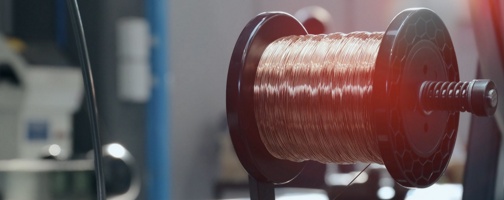To perform most welding processes, a filler material must be used: if, in the past, coated electrodes were normally chosen, wire welding has now evolved significantly and is increasingly used to replace the process using electrodes.
The welding wire is delivered in practical reels and does not require work interruptions, material replacements or scrap removal during the welding and brazing processes, making them both much easier to perform and also more productive.
In this article we provide a more specific insight to the product, from different types of welding and brazing wire to production in metal processing machines.
What is welding wire and what it is used for
Unlike direct welding, where just heat is used to join two materials, wire welding incorporates a different filler material in relation to the base metal and is delivered in continuous wire reels, from which the term derives.
There are two types of metal wires for welding and brazing processes:
– Solid welding wire, that may consist of different types of metal (steel, copper, silver, tin, etc.). Welding by solid wire is achieved by combining the addition of an active or inert gas provided by the welding tool or torch, which protects the material against oxidation.
– Flux-core wire, that generally consists of a hollow filler metal, inside which compounds of metallic powders are inserted; as the wire melts it compensates for the external gas supply and protects the surface of the welding seam accordingly.
Metal alloys used for welding wire
Another important point should be clarified: welding and brazing operations with metal wire differ mainly as regards to their operating temperature. Brazing uses a metal alloy filler with a melting point significantly lower than that of the metals being processed, in order to keep them intact and ensure they do not melt together with the welding alloy.
For this reason, brazing is also used in other fields than industrial sectors, depending on whether a soft or strong brazing is required, the latter also called braze welding.
Silver alloys are among the most versatile welding and brazing alloys, widely used for both ferrous and non-ferrous metals. These wires are made of a part in silver and a mixture of various materials such as copper, manganese, nickel or tin, each of which contributing particular properties.
Generally speaking, silver alloy welding and brazing wire operates smoothly with high corrosion resistance, fluidity and capillarity in the filling phase.
How welding wire is manufactured
Whatever the specific situation and requirement, the manufacturing quality of the welding and brazing wire plays a key role in the success of the finished product.
Welding wire can be manufactured by:
– Wire rod reduction: this method is used to manufacture solid welding wire. Depending on its chemical-physical characteristics, the wire rod is processed in drawing or rolling machines to reduce its thickness and diameter.
– Forming of metal strips: this is the preferred method when manufacturing flux-core wire, as it improves the mechanical characteristics of the semi-finished product and also reduces the costs and waste associated with the drawing process.
In fact, more often than not, welding and brazing wire is manufactured through metal drawing processes: here you can see why metal cold rolling can be a better alternative.
Wire manufacturing through cold rolling makes it possible to solve the problems caused by the drawing pull, which could cause twisting of the material due to the multiple passes between the machines; what’s more, metal cold rolling maintains a homogeneous crystalline grain and resolves defects in the casting process, such as blow holes and porosity.
INVIMEC: bespoke welding wire solutions
Given our metal processing expertise gained in over 60 years in the industry, at INVIMEC we have studied the needs and requirements of the welding and brazing wire manufacturers, designing concrete solutions for the cold rolling phase – crucial for the production quality of the wire.
Our welding wire tandem rolling mill, equipped with cutting edge programs and algorithms, envisages highly controlled processing aimed at reducing waste and production times. We also have a special rolling mill dedicated to the production of silver alloy wire, with automated systems for ease of handling of the wire reels.
Contact us to build your own welding and brazing wire manufacturing line!
